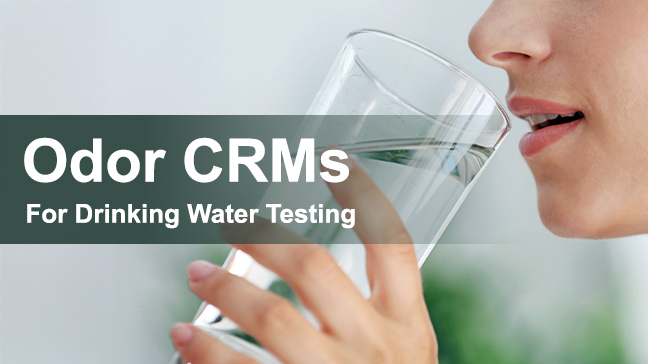Click "Allow Cookies" to consent to storing cookies on your device to improve your experience on our site. Learn more.
CRMs for Testing Odor Compounds in Drinking Water


October 22nd, 2025
Odor-causing chemicals are a group of compounds that can produce unpleasant smells in drinking water, even at trace-level concentrations. While many of these compounds may not pose significant health risks, accurate testing is essential to ensure high water quality and to enable early detection of contamination from sources such as sewage or industrial discharge.
Standard Method 6040D - Odor Compounds in Drinking Water
Standard Method 6040D targets 19 organic compounds known to cause taste and odor issues such as geosmin, 2-methylisoborneol (2-MIB), and certain methoxypyrazines. The method uses Solid-Phase Microextraction (SPME) coupled with Gas Chromatography/Mass Spectrometry (GC/MS) to detect these compounds at very low-level concentrations.
While some compounds like geosmin and 2-MIB occur naturally and often linked to algal blooms, others may result from industrial pollution or sewage contamination. Even if water meets all safety standards, unpleasant odors can lead to public complaints, reduced trust, and the perception that the water is unsafe.
The use of high-quality certified reference materials (CRMs) for odor-causing compounds is essential for the reliable testing of these compounds, which is critical for developing effective water treatment methods and response procedures.
Reference Standards for Odor Compounds
To support water quality monitoring and help maintain consumer confidence, AccuStandard has developed a comprehensive range of taste and odor standards designed for the use with Standard Method 6040D and other analytical methods. These standards enable laboratories and water treatment facilities to accurately detect and quantify odor-causing compounds in drinking water.
Need Assistance with Odor Standards?
To find additional Odor Reference Standards, you can shop our full selection here.
If you still don’t see what you are looking for, reach out to techservice@accustandard.com and we can make a recommendation or create a custom product for you.
